SS 9-1 use Google Classroom code: ykiwe72
SS 9-2 use Google Classroom code: 3j2pno5
UNIT 1 - Integrated Concepts & Processes
Using your text (Canadian Identity, 2011) choose THREE(3) of the 10 pictures (page 4 to 9) and answer the following questions:
How to Critique a Cultural Image
1.Who created the image and when? What is it about? What is the title? What objects (e.g.,
people, animals, buildings, vegetation, landforms) do you see?
2. What do you think this image is about? What title would you give it? Do you think the organization of the objects, colours used, and the medium are good? How does this image make you feel?
3. How are Canadians portrayed? What does this image tell others about Canadian identity? How do you know?
4. Do you think the creator of the image is talented and why? Would you describe it as weak,
good, or excellent?
Unit 2 - Exploring Canadian Identity
UNIT 2 (Outcomes 2.1 & 2.2)
"Landform Regions"
Draw an outline map of Canada (see page 27 of your text); use appropriate colour legend to show the extent and location of the major landform regions. Find
photos of a landscape for each region to paste around the boundary of the map. Draw lines to relate the photo to the appropriate region.
EVALUATION: 8 land forms = 8 marks
Unit 2 (Outcomes 2.3)
"Climate & Weather"
Using the Chromebook, replicate the following chart, filling out the blank cells in the right column:
EVALUATION: 5 cells in table = 5 marks
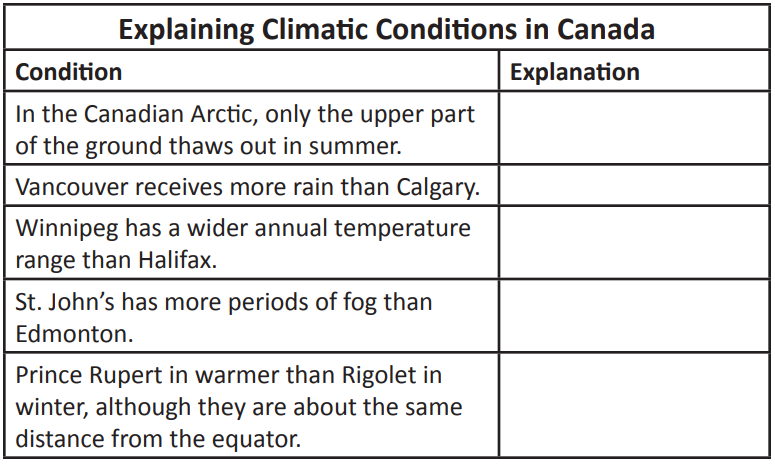
Unit 2 (Outcomes 3.1 & 3.2)
"Canadian Settlements"
Using the Chromebook, replicate the following chart, filling out the blank cells in the right column:
EVALUATION: 4 cells in table = 4 marks
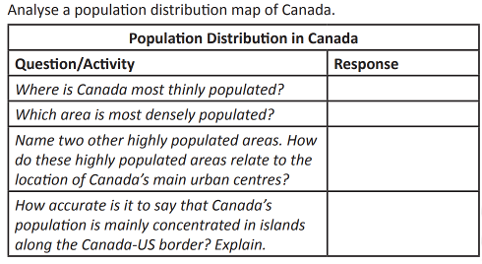
Unit 2 (Outcome 3.3)
"Canadian Regions"
Canada: Regional Attributes
Atlantic Canada Quebec
Ontario Prairies
British Columbia Canadian North
EVALUATION: 3 areas + 3 attributes =6 marks
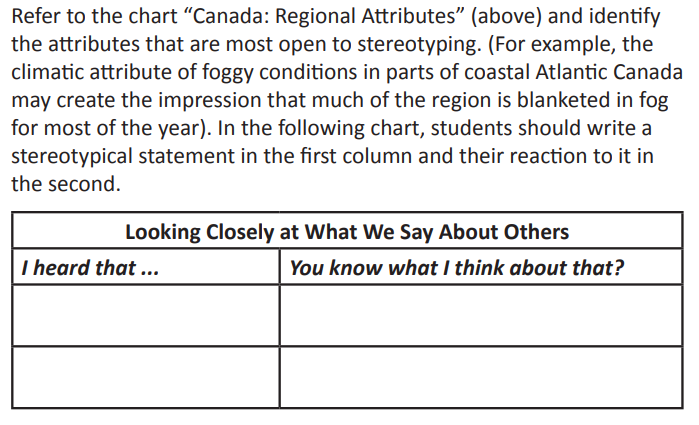
Unit 2 (Outcomes 4.1, 4.2, & 4.3)
"Immigration"
See page 67 of your text book (page 61 of the curriculum guide).
EVALUATION: 4 cells in table = 4 marks
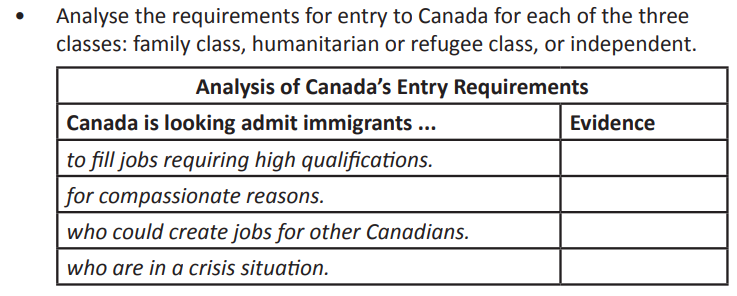
Unit 2 (Outcomes 4.4 & 4.5)
"Migration"
In attempting to understand internal migration (why someone would move from one part of Canada to another), students will write out 5 questions they would have for such migrants.
EVALUATION: 5 questions = 5 marks
This YouTube video is a documentary of the history of St. John's Harbour. The harbour was terribly outdated when it joined with Canada in a Confederation in 1949. This film documents the efforts to modernize the flow of traffic around the harbour, expand roads and access and build new warehouses on the waterfront. The old-fashioned finger docks (for sailing vessels) were removed.
Unit 3 - Significant Events
UNIT 3 (Outcome 5.1)
"1921 Prosperity"
Draw a map of Canada with THREE(3) 1920s economic growth labels (with bubble notes underneath) and THREE(3) 1920seconomic decline labels (with bubble notes underneath). Put the labels in the correct geographic location on the map.
EVALUATION: 3 growth + 3 decline = 6 marks
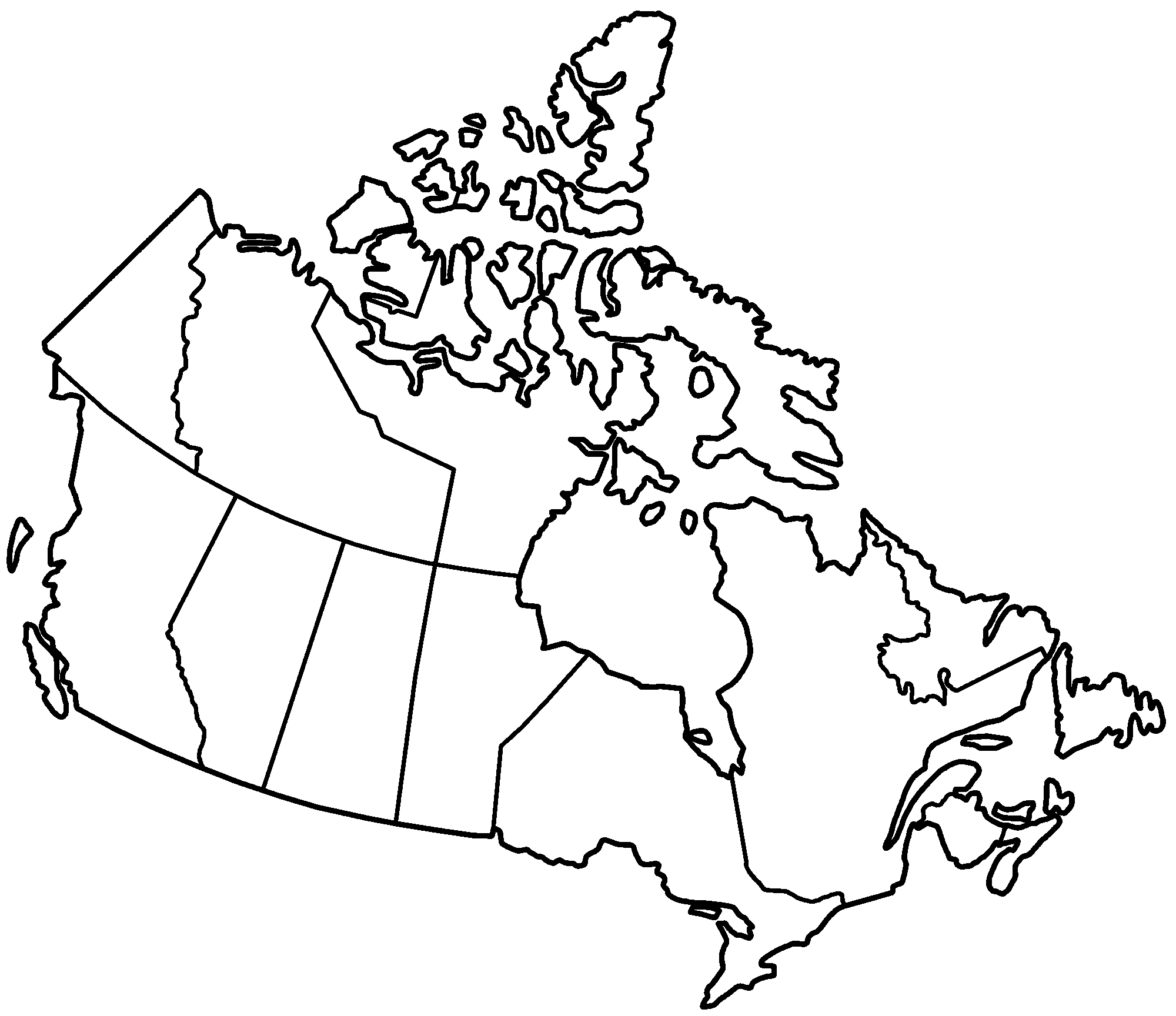
Unit 3 (Outcome 5.2)
"Lifestyle & Technology"
Describe how new appliances introduced in the 1920s saved time or made life easier. Then, name products that have become popular over the last 20 years and describe how they save time or make life easier. The chart below may help organize this information:
EVALUATION: 12 cells (minimum) = 12 marks
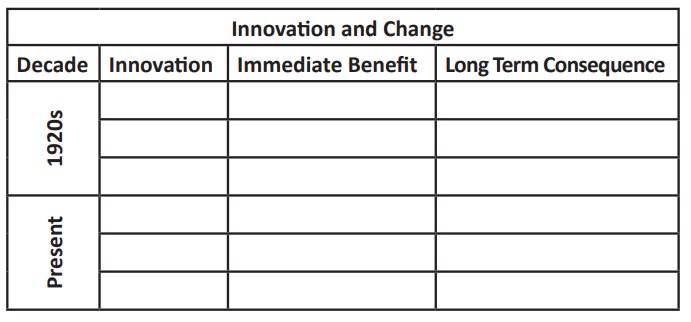
Unit 3 (Outcomes 5.3 & 5.4)
"The Great Depression" (causes & effects)
GOOGLE DOCS: Use photographs to investigate life during the depression of the 1930s in various regions of Canada (Martimes, Quebec, Ontario, Prairies, & British Columbia). Organize the images in the photographic / visual essay, adding captions that draw appropriate inferences from each image. (Note: Students should use a photograph analysis sheet to guide their inquiry, see attachment below.)
EVALUATION: 6 items per sheet X 5 images = 30 marks

|
SS 9 - Photograph Analysis Sheet.pdf Size : 53.393 Kb Type : pdf |
Unit 3 (Outcome 6.1)
"The Road to War"
Which of the following factors contributed most to the outbreak of World War 2?
(A) Treaty of Versailles
or
(B) Appeasement
Justify your answer (most students wrote a paragraph in their exercise and showed it to the teacher for evaluation)
EVALUATION: 5 marks
Unit 3 (Outcome 6.2)
"Phases of the War"
As a nation, Canada made several contributions to World War 2. What was Canada's most important? Support your choice.
EVALUATION: 5 marks
Unit 3 (Outcome 6.3)
"War in the Pacific"
EVALUATION: 12 marks
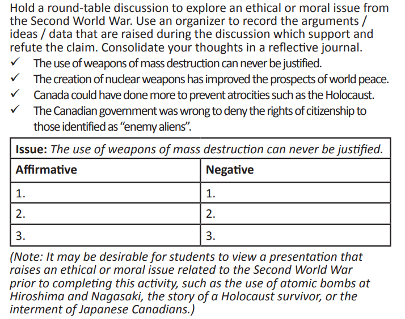
Unit 3 (Outcome 7.1)
"The War at Home"
"The Second World War was a catalyst* for change for all the countries that fought in it".
Using THREE(3) examples, identify what you believe to be the most significant effects of the Second World War on Canadian identity.
*CATALYST: A person or event that causes change
EVALUATION: 6 marks
Unit 3 (Outcome 7.2)
"Ethnic & Cultural Relations"
EVALUATION: 12 marks
For this question, consider Canadian Japanese (page 120), Jewish refugees (page 121), Africans (page 122), and First Nations (page 123).
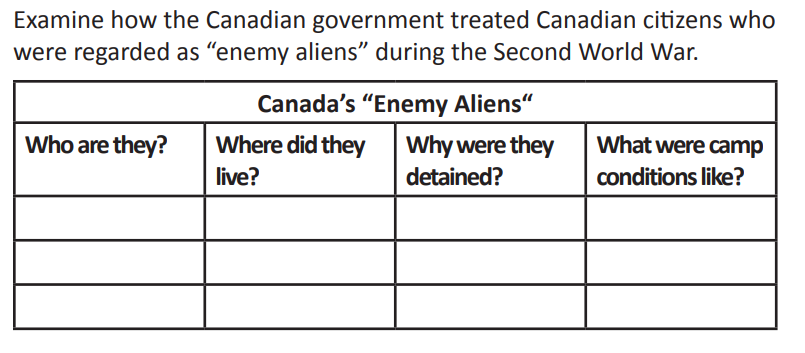
Unit 4 - Part of The Global Community
UNIT 4 (Outcome 8.1)
"The Cold War"
Create and colour code a map to illustrate the two alliances of the Cold War (NATO members & Warsaw Pact members from 1945-1991).
EVALUATION: 20 founding countries =20 marks
Warsaw Pact
1. Albania
2. Bulgaria
3. Czechoslovakia
4. East Germany
5. Hungary
6. Poland
7. Romania
8. Soviet Union
NATO
9. Belgium
10. Canada
11. Denmark
12. France
13. Iceland
14. Italy
15. Luxembourg
16. Netherlands
17. Norway
18. Portugal
19. UK
20. USA
Unit 4 (Outcome 8.2)
"Canada & The Cold War"
Why would Canada agree to surrender some of its sovereignty / autonomy to the United States of America with its involvement in NORAD (The North American Aerospace Defense Command)? Is this rationale reasonable? Explain.
EVALUATION: 5 marks.
Unit 4 (Outcome 9.1)
"Technology & Lifestyle"
Investigate the influence of technological change and innovation on Canadian lifestyle during the 1950s using the following: 1) automobiles, 2) aluminum, 3) unbreakable glassware, 4) stereo sound, and 5) television
EVALUATION: 5 objects (x2 columns) + 1 concluding sentence = 11 marks
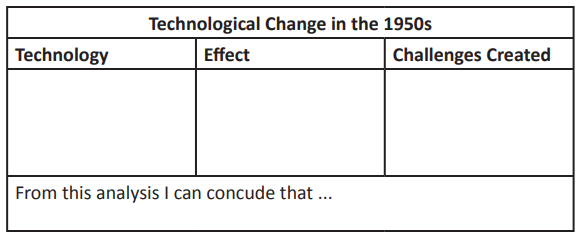
Unit 4 (Outcome 9.2)
"Attitudes & Values"
Support (or refute) the following claims about social change in the 1950s with evidence:
EVALUATION: 2 marks per claim = 6 marks
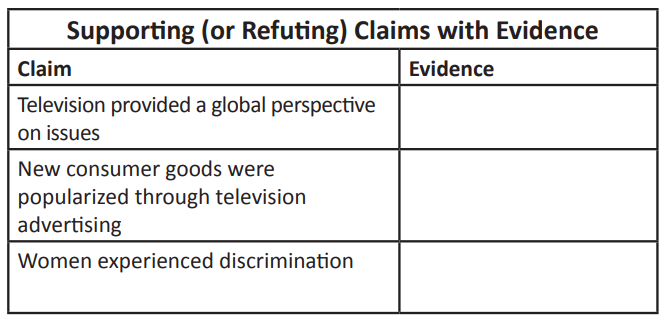
1960s Canadian Concerns (injustices):
- autonomy for First Nations and Inuit
- Canadian policy of multiculturalism
- civic rights
- folk music
- hippie movement
- political protests (Vietnam War; environmentalism; nuclear arms race)
- women's right
Unit 4 (Outcome 10.1)
"1950s Conformity"
Identify and explain the meaning of expressions from the 1960s:
1. bread
2. far out
3. rap
4. groovy
5. good vibes
6. flower child
7. psychedelic
8. cool
9. square
10. cat
11. chick
Write a paragraph describing how these expressions reflect the counterculture of the decade. (Note: These expressions reflected a culture that was outside the dominant culture and was thus referred to as counterculture. This counterculture rejected social norms and used a language that deliberately excluded outsiders.)
EVALUATION: 11 terms + 3 (for paragraph) = 14 marks
Unit 4 (Outcome 10.2)
"A Developing Idealism"
Assume you lived in Canada during the 1960s. Write a letter to a local, provincial, or federal politician outlining your concerns about an injustice you see occurring in the country. Explain why you are concerned and make some constructive suggestions about how to improve the situation.
EVALUATION: 10 marks (proper business letter format; 3 issues within your one injustice topic; practical solutions; & effective tone)
Unit 4 (Outcome 11.1)
"What is Globalization?"
Discuss the validity of phrases in Google Docs:
1. “MacWorld”,
2. “Coca Cola Culture”
3. “Wally World“
These are phrases that are often used to describe the globalization
and Americanization of the world economy and culture. Tell what each phrase means and if they are accurate (or not).
EVALUATION: 6 marks
Unit 4 (Outcome 11.2)
"The Cold War End"
Re-create the following table in Google Docs, filling in the missing TWO(2) cells:
EVALUATION: 6 marks
BACKGROUND and VIDEO

Unit 4 (Outcome 11.3)
"Economic Globalization"
Suggest the Consider Perspective that each of the following people
might have regarding free trade. Provide reasons for that view in A Google Docs:
I am ... My Consider Perspective is ...
- a business owner hoping to expand in size and increase income
through new markets - a shareholder in a large Canadian company that has 30 percent of
its business dependent on trade with California - a shareholder in a Canadian company that will lose its tariff protection
- an unemployed person
- a farmer whose grain is sold on open world markets
- the mayor of a small town where textile factories are protected
from foreign competition by a tariff
EVALUATION: 6 marks
Unit 4 (Outcome 11.4)
"Cultural Globalization & The Media"
If you were the Prime Minister of Canada, identify five measures that
you would adopt to ensure that Canadian culture is protected. Rank
order your list and explain the purpose of each measure in a Google Docs.
EVALUATION: 5 orders + 5 explainations = 10 marks
Unit 5 - Citizenship & Identity
Unit 5 (Outcome 12.1 & 12.2)
"Citizenship"
Complete an "Anticipation Guide" on the concept of citizenship. Students respond with "agree" or "disagree" to a series of statements about citizenship.
EVALUATION: A or D + 2 reasons X 5 = 15 marks
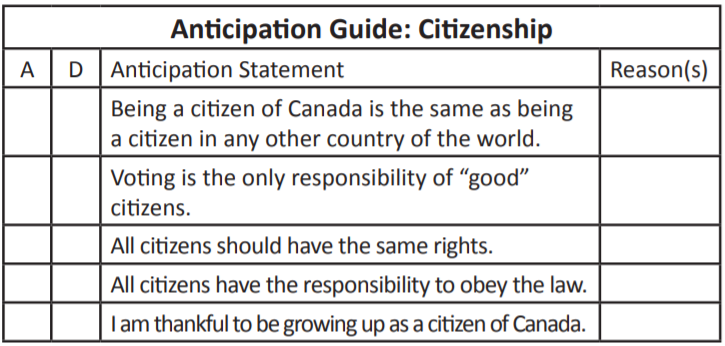
Unit 5 (Outcome 12.3 & 12.4)
"Rights"
Assume the role of citizenship judge and prepare a chart to help instruct the recent immigrants on the rights and responsibilities of Canadian citizenship. Use simple and clear language. The link below informs you of NINE(9) rights and SIX(6) responsibilities.
EVALUATION: 9 rights + 6 responsibilities = 15 marks

Unit 5 (Outcome 13.1)
"Roots of Modern Democracy"
Students should identify the central concept of citizenship (and the timeframe) that emerged within each of the following milestones:
- The Code of Hammurabi
- Athenian Democracy
- Roman Law
- Magna Carta
- English Civil War and Glorious Revolution
- Revolution in the United States
- Revolution in France
EVALUATION: 14 marks (date and explanation for 7)
Unit 5 (Outcomes 13.2 & 13.3)
"Citizenship in Canada"
Research key events in Canadian history to identify how ideas of citizenship have changed over time.
EVALUATION: 47 marks(each empty cell)
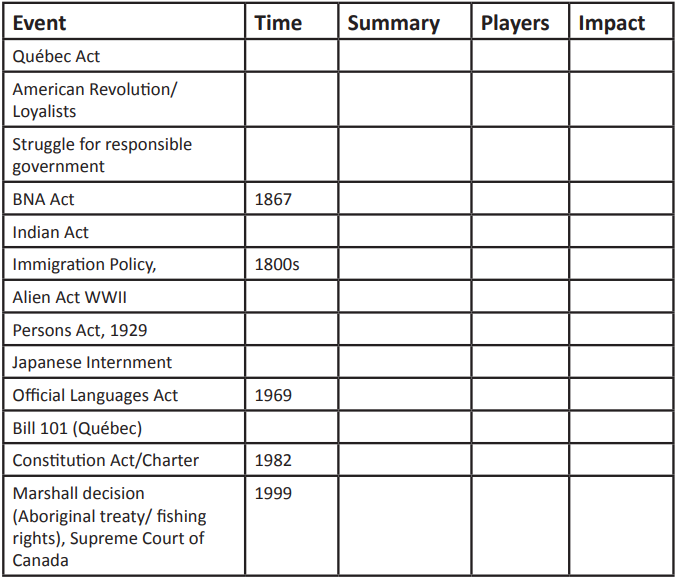
Unit 5 (Outcome 14.1)
"Canadian Federal System"
Create a Google Slides to show the structure of the federal government (use pictures/icons/symbols). Use the following labels/headings/subheadings (and explain the function of each):
- EXECUTIVE (King/Queen & Governor General, Prime Minister's Office, Cabinet, & Privy Council)
- LEGISLATIVE (Senate, House of Commons, & Parliamentary Committees)
- JUDICIAL (Justices at the Supreme Court of Canada and other judges at a series of independent courts)
EVALUATION: 9 marks
Unit 5 (Outcome 14.2)
"Evolution of Federalism" - [EMPTY]
Unit 5 (Outcome 14.3)
"Organization of Government"
Complete the following table:
EVALUATION: 6 marks

Unit 5 (Outcome 14.4)
"Rule of Law"
Within Google Docs, explain what is wrong with vigilante justice.
EVALUATION: 5 marks
Unit 5 (Outcome 14.5)
"Elections"
Within Google Docs, answer the following TWO(2) questions:
1. What is the most important part of the electoral process in Canada?
2. Should voting be compulsory under Canadian law? Why?
EVALUATION: 6 marks